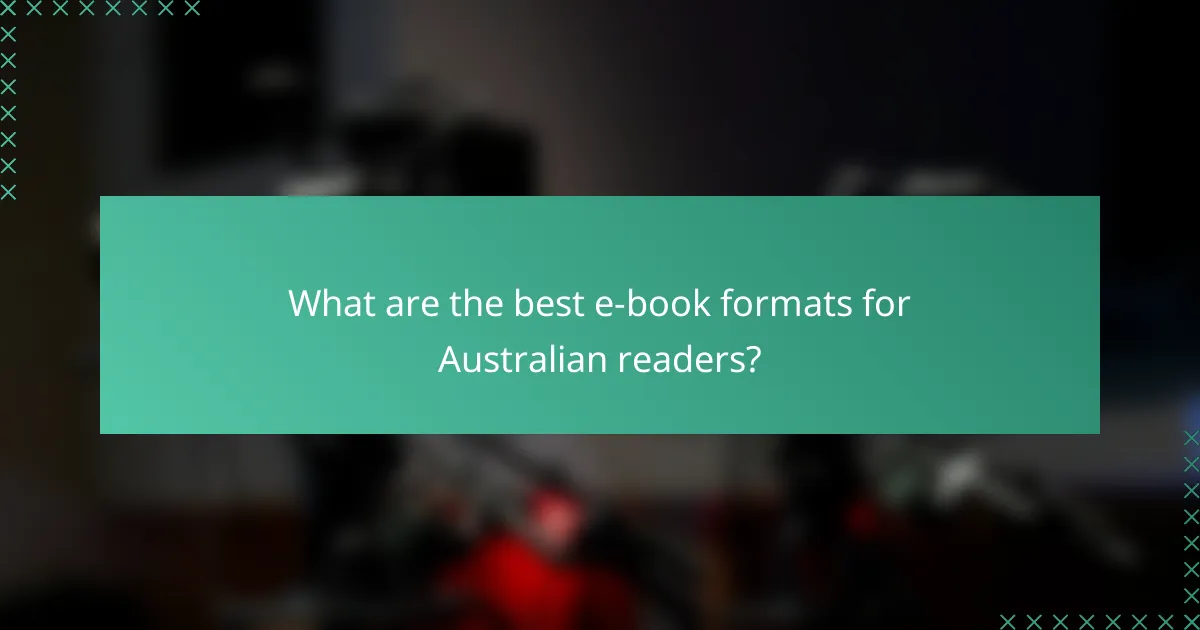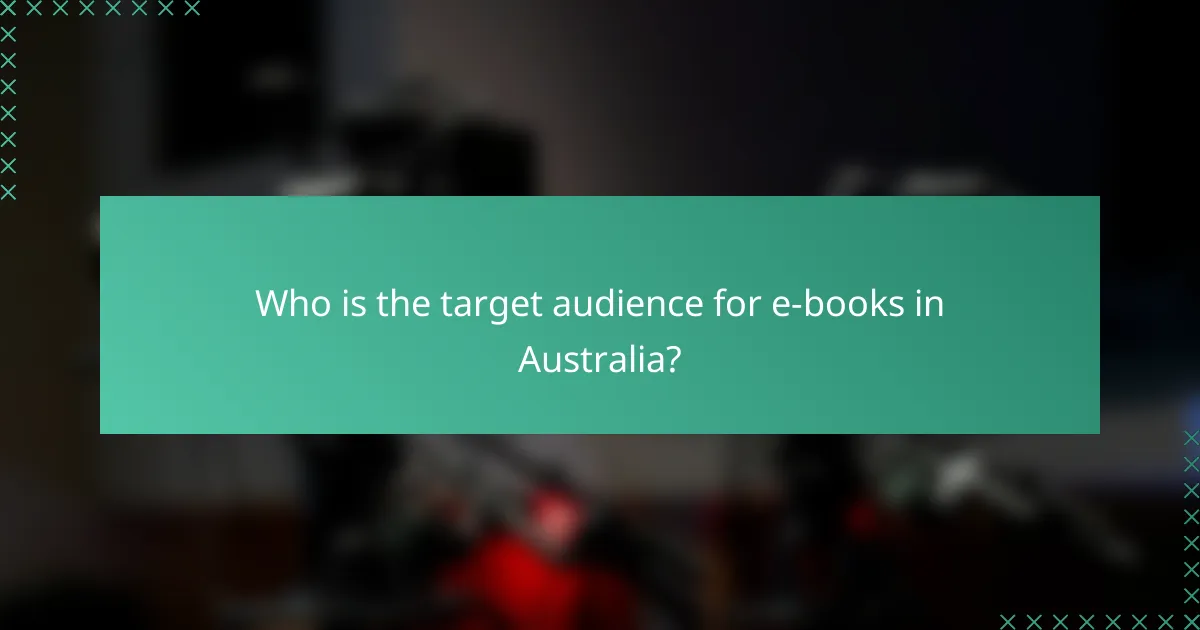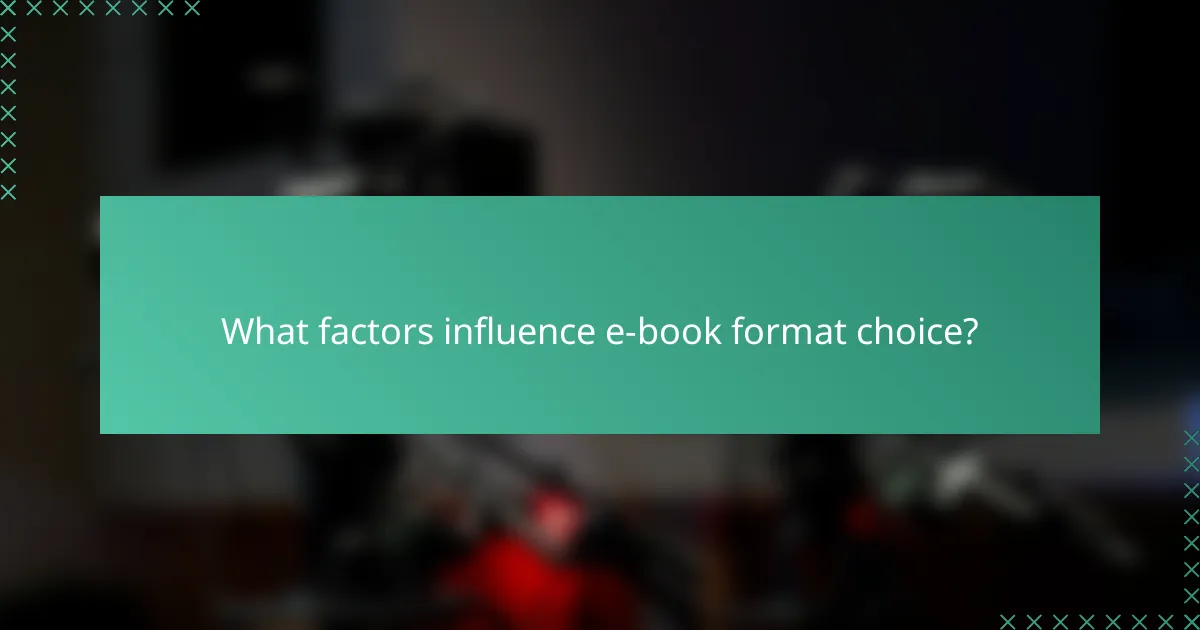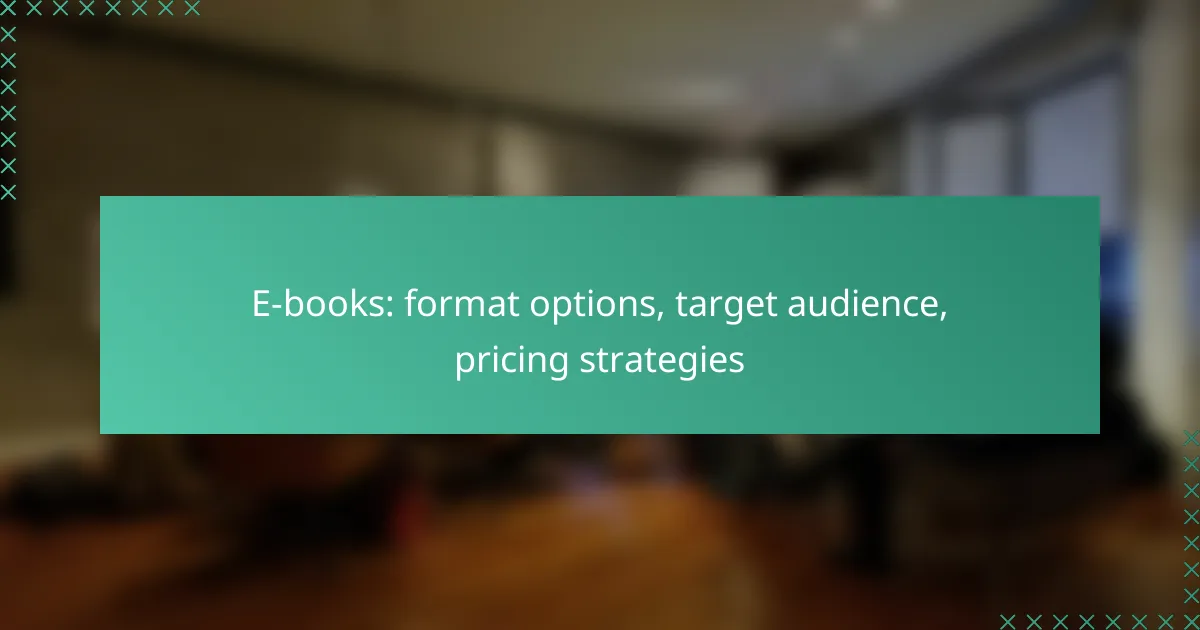E-books have become increasingly popular in Australia, offering various formats such as EPUB, MOBI, and PDF to cater to diverse reading preferences and device compatibilities. The target audience spans students, professionals, and casual readers, all seeking the convenience and accessibility that e-books provide. To effectively reach these audiences, authors and publishers can employ pricing strategies like dynamic pricing, subscription models, and bundling offers, each designed to maximize market reach and revenue.

What are the best e-book formats for Australian readers?
The best e-book formats for Australian readers include EPUB, MOBI, PDF, KFX, and HTML. Each format has unique features that cater to different reading preferences and device compatibilities.
EPUB format
EPUB is a widely used e-book format that supports reflowable content, making it ideal for various screen sizes. It is compatible with most e-readers, including Apple Books and Kobo devices, allowing for a flexible reading experience.
One key advantage of EPUB is its support for multimedia elements, such as audio and video, which can enhance the reading experience. However, ensure that your e-reader supports EPUB before purchasing or downloading books in this format.
MOBI format
MOBI is primarily associated with Amazon’s Kindle devices, making it a popular choice for readers who use Kindle apps or e-readers. This format allows for easy access to Amazon’s extensive library of e-books.
While MOBI files are optimized for Kindle, they lack some advanced features found in EPUB, such as multimedia support. If you plan to read on a Kindle, MOBI is the preferred format, but it may not be suitable for other devices.
PDF format
PDF is a fixed-layout format that preserves the original design of the document, making it suitable for textbooks, manuals, and documents with complex layouts. It is widely supported across devices, including computers and tablets.
However, the fixed layout can be a drawback for smaller screens, as text may not reflow. For reading on mobile devices, consider using a PDF reader that allows zooming and scrolling for a better experience.
KFX format
KFX is an advanced format used by Amazon for its Kindle devices, offering features like enhanced typography and support for complex layouts. It is designed to improve the reading experience on Kindle e-readers and apps.
While KFX provides a superior reading experience, it is not compatible with non-Kindle devices. If you are a Kindle user, KFX can enhance your reading with better formatting and features.
HTML format
HTML is a versatile format that can be used for e-books, especially for web-based reading. It allows for interactive elements and is easily accessible through web browsers, making it suitable for online reading platforms.
However, HTML e-books may not have the same level of compatibility with dedicated e-readers. If you are creating content for online distribution, HTML can be a great option, but ensure it is optimized for various devices.

Who is the target audience for e-books in Australia?
The target audience for e-books in Australia includes a diverse range of readers, each with unique needs and preferences. Key groups include students, professionals, casual readers, and business owners, all of whom seek the convenience and accessibility that e-books offer.
Students
Students are a significant audience for e-books, as they often require access to a variety of texts for their studies. E-books provide an affordable alternative to traditional textbooks, often at a fraction of the cost, making them appealing for budget-conscious learners.
Many educational institutions in Australia now incorporate e-books into their curricula, allowing students to access required readings digitally. This shift not only enhances convenience but also supports interactive features like highlighting and note-taking.
Professionals
Professionals in various fields utilize e-books for continuous learning and skill development. E-books offer a flexible way to stay updated with industry trends and best practices, often available in formats that are easy to read on-the-go.
For instance, professionals might choose e-books on topics like management, technology, or finance, which can be accessed via tablets or smartphones during commutes. This accessibility allows for efficient use of time and resources.
Casual readers
Casual readers represent a broad segment of the e-book market, seeking entertainment and leisure reading. E-books cater to this audience by providing instant access to a vast library of genres, from fiction to non-fiction.
With many e-book platforms offering subscription services, casual readers can explore new titles without a significant financial commitment. This model encourages exploration and discovery of new authors and genres.
Business owners
Business owners often turn to e-books for insights on entrepreneurship, marketing, and management strategies. E-books can serve as valuable resources for learning about best practices and innovative approaches to running a business.
Additionally, e-books can be used as marketing tools, allowing business owners to publish their expertise and attract potential clients. Offering free e-books in exchange for email subscriptions is a common strategy to build a customer base.

What pricing strategies work for e-books in Australia?
Effective pricing strategies for e-books in Australia include dynamic pricing, subscription models, bundling offers, and freemium models. Each approach has unique advantages and can cater to different segments of the market, helping authors and publishers maximize their reach and revenue.
Dynamic pricing
Dynamic pricing involves adjusting e-book prices based on demand, competition, or other market factors. This strategy allows publishers to optimize sales by lowering prices during slow periods and increasing them when demand is high.
For example, an e-book might be priced at AUD 9.99 during its launch week and then adjusted to AUD 14.99 after initial sales peak. Monitoring sales data regularly is crucial to effectively implement this strategy.
Subscription models
Subscription models allow readers to access a library of e-books for a monthly fee. This approach can attract avid readers who prefer variety and convenience over purchasing individual titles.
Platforms like Scribd or Kindle Unlimited offer subscriptions ranging from AUD 10 to AUD 15 per month, providing access to thousands of titles. Publishers should consider the potential for steady revenue and increased readership when adopting this model.
Bundling offers
Bundling offers involve selling multiple e-books together at a discounted price. This strategy can entice readers to purchase more titles than they might individually buy, increasing overall sales.
For instance, a series of novels could be bundled for AUD 29.99 instead of selling each book for AUD 12.99. This approach not only boosts sales but also encourages readers to explore more of an author’s work.
Freemium models
The freemium model allows readers to access a limited version of an e-book for free, with the option to purchase the full version or additional content. This strategy can effectively attract new readers and generate interest in the full product.
For example, offering the first chapter of an e-book for free can entice readers to buy the complete version for around AUD 9.99. This approach can be particularly effective for new authors looking to build an audience.

What factors influence e-book format choice?
Several factors influence the choice of e-book format, including device compatibility, user experience, and content type. Selecting the right format ensures that your e-book is accessible and enjoyable for your target audience.
Device compatibility
Device compatibility is crucial when choosing an e-book format, as different devices support different formats. Popular formats include EPUB, MOBI, and PDF, each with varying levels of support across e-readers, tablets, and smartphones.
For instance, EPUB is widely supported on most e-readers except Amazon Kindle, which primarily uses MOBI. Consider your audience’s preferred devices when selecting a format to maximize accessibility.
User experience
User experience significantly impacts how readers interact with e-books. Formats that allow for adjustable text size, background color changes, and interactive elements tend to enhance readability and engagement.
EPUB and interactive PDF formats often provide a better user experience compared to fixed-layout formats like PDF, which can be less flexible on smaller screens. Prioritize formats that offer a seamless reading experience to keep your audience engaged.
Content type
The type of content you are publishing also influences the choice of e-book format. Text-heavy books, such as novels or academic texts, may perform well in EPUB or MOBI formats, while graphic novels or textbooks might benefit from fixed-layout formats.
For example, if your e-book includes many images, charts, or complex layouts, consider using a format that preserves the design, like PDF. Assess the nature of your content to select the most suitable format for your e-book.

How to optimize e-book pricing for the Australian market?
To optimize e-book pricing in Australia, consider factors like market demand, competition, and consumer behavior. Setting a price that reflects both the value of your content and the expectations of Australian readers is crucial for success.
Market research
Conducting thorough market research is essential for understanding the Australian e-book landscape. Analyze competitors’ pricing strategies, popular genres, and reader preferences to identify trends and gaps in the market.
Utilize tools like surveys and social media polls to gather insights directly from potential readers. This feedback can help you tailor your pricing to align with what Australian consumers are willing to pay.
Keep an eye on local e-book platforms such as Amazon Australia and Apple Books to monitor pricing fluctuations and promotional strategies. Adjust your pricing based on seasonal trends and special events to maximize sales opportunities.
